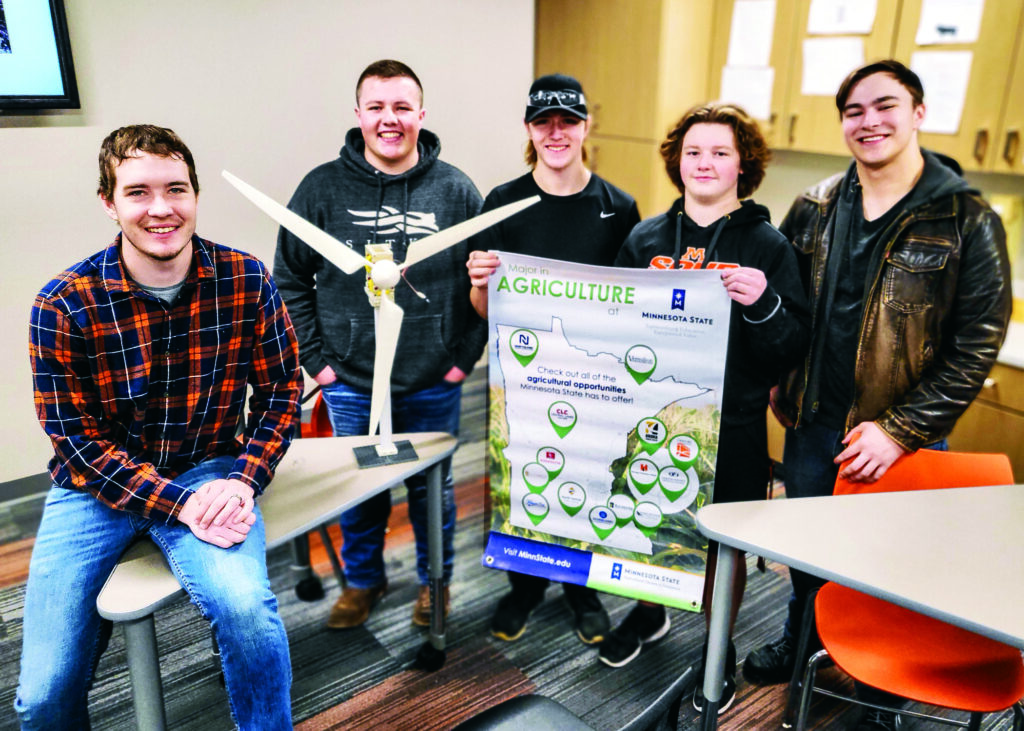
Instructor Gabe Lassila — shown here with students Sam Case, Cadyn Brown, Lyric Cogger and Christian Larson — is teaching the first semesters of Moorhead High’s ambitious new Farm to Table curriculum. (Photo/Russ Hanson.)
Nancy Edmonds Hanson
Forty years ago, agriculture classes were dropped from the Moorhead High School curriculum.
In the 2021-22 school year, they came back, and then some.
“Ag fizzled out,” says assistant principal Andrea Thiner. When enrollment sagged and the district couldn’t find a teacher, the course was quietly eliminated in 1981.
Today, though, ag is coming back … and bringing its friends. Quartered in the new Moorhead Career Academy, the district’s emerging Farm to Table program links agricultural production to the natural resources that support it and the culinary profession that serves up the finished products – going beyond ground level to the broad spectrum of the vital and growing industries that are rooted in the soil.
“We wanted to show the big picture from end to end – where our food comes from and how it’s used,” Thiner explains.
Ag instructor Gabe Lassila adds, “A lot of people don’t think much about the connections. They still think chocolate milk comes from brown cows. We’re going to change that.”
The Farm to Table curriculum was developed with the help of an advisory committee of area farmers, educators (the M State farm business management instructor, the associate dean of the North Dakota State University College of Agriculture), several ag lenders and a rep from RDO Equipment. Other members include a former Clay County Extension agent and the regional director of Minnesota Future Farmers of America. Ag consultant Steve Olson also was part of the group – an MHS grad who was part of that final ag class in 1981.
In the Career Academy’s inaugural year, the Farm to Table initiative has started small. Lassila, who’s in his third year at MHS, has about 40 young men and women in his three Introduction to Ag courses and another 60 or so in three sections of Ag Construction. That will be expanded over the next two school years. Plant Science, Animal Science and Horticulture are on the agenda for 2022-23. Agribusiness and Intro to Precision Ag will be added in Fall 2023. Plans call for a greenhouse, perhaps next year, that will expand the options for hands-on learning.
A separate Agricultural Mechanics program is also offered to round out the options.
On the foods end of the spectrum, the curriculum began with the basics of Food and Consumer Science in 2021. Next year, culinary studies will launch with International Food/World Geography and Chemistry in the Kitchen. More vocation-specific classes – Foundations of Restaurant Management & Culinary Arts – are on the calendar for 2023-24. Eventually, Thiner says, the ag greenhouse could grow some of the food prepared in the kitchen classrooms and served to students.
Natural resources, too, play a part in the new Farm to Table focus. Those studies will start up with Intro to Natural Resources and Conservation Science next year, followed by Environmental Issues, Alternative Energy, and Landscape Architecture in 2023-24 and, finally, Environmental Sustainability and Waste Engineering in the fall of 2024.
Lassilla points out that career options abound in each of the three concentrations. “Exposure to agriculture exposes you to all kinds of possibilities in addition to farming,” he points out. “There are so many careers you don’t even think about.” He points to ag finance and banking, ag-related businesses like seed, fertilizer and other specialties, and hot new careers in precision agriculture using drones and other technology. Animal science prepares butchers. Researchers are needed in animal and crop genetic science.
Natural resources studies, too, open many doors – from retail greenhouse management to soil conservation and jobs in wildlife and environmental management.
And then there is the route Lassila himself has taken. He found his way in the ag direction as a high school student in Garrison, North Dakota, where a favorite teacher pointed out that agriculture teachers were in high demand. “He told me, ‘If you want to teach agriculture, the jobs will be lined up waiting for you when you get out of school.’”
He was right. Graduating from North Dakota State University in 2019 with a degree in ag education and animal science, Lassila was hired immediately by the Moorhead school system.
“This is what I’ve wanted to do since I was a senior in high school,” he says. “I guess I was like a lot of kids. I took ag because it sounded interesting to me, and then I was hooked. The possibilities are endless.”


